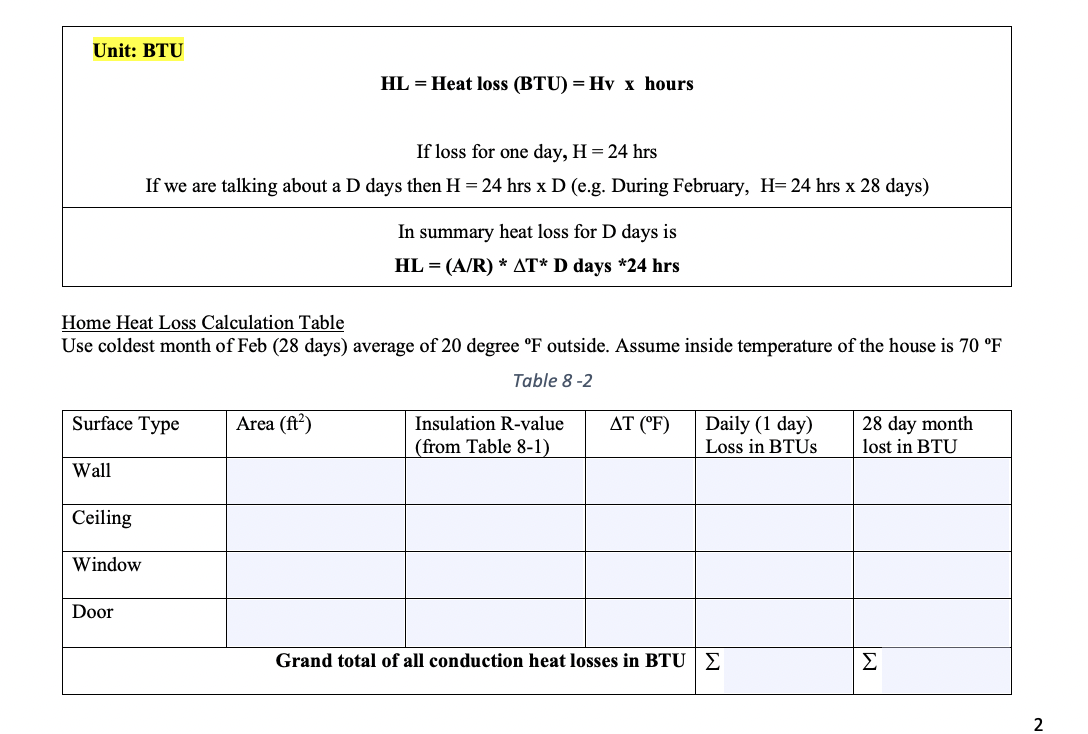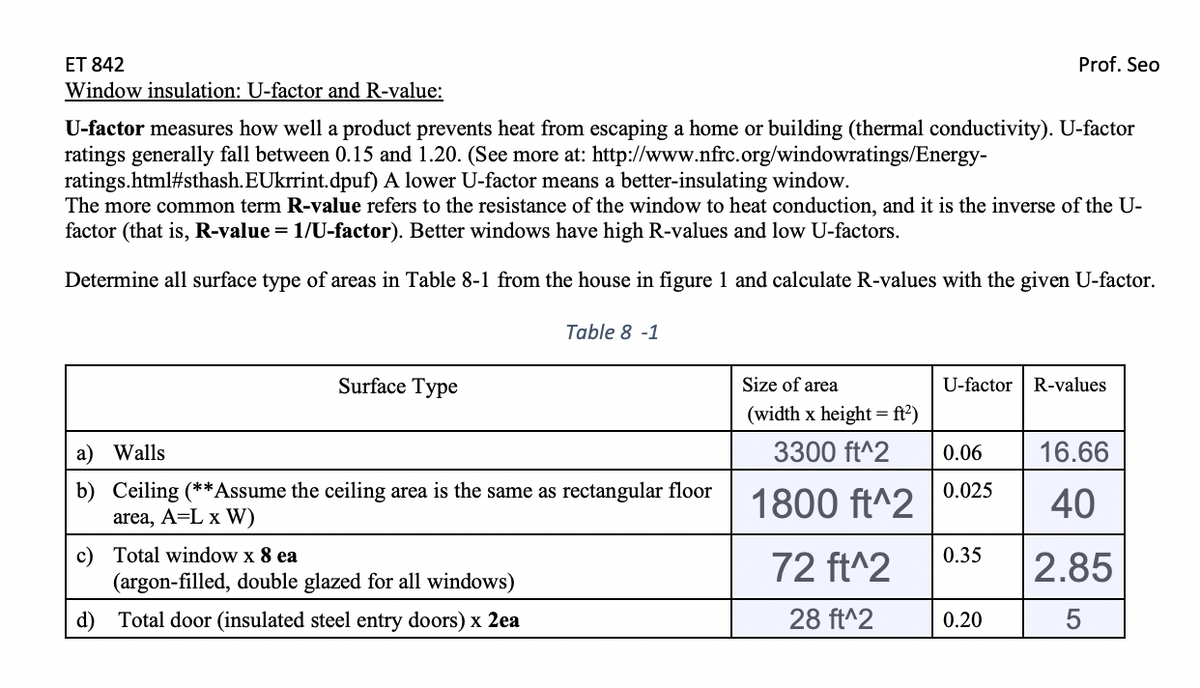Unit: BTU HL = Heat loss (BTU)= Hv x hours If loss for one day, H = 24 hrs If we are talking about a D days then H = 24 hrs x D (e.g. During February, H= 24 hrs x 28 days) In summary heat loss for D days is HL = (A/R) * AT* D days *24 hrs Home Heat Loss Calculation Table Use coldest month of Feb (28 days) average of 20 degree ºF outside. Assume inside temperature of the house is 70 °F
Unit: BTU HL = Heat loss (BTU)= Hv x hours If loss for one day, H = 24 hrs If we are talking about a D days then H = 24 hrs x D (e.g. During February, H= 24 hrs x 28 days) In summary heat loss for D days is HL = (A/R) * AT* D days *24 hrs Home Heat Loss Calculation Table Use coldest month of Feb (28 days) average of 20 degree ºF outside. Assume inside temperature of the house is 70 °F
Elements Of Electromagnetics
7th Edition
ISBN:9780190698614
Author:Sadiku, Matthew N. O.
Publisher:Sadiku, Matthew N. O.
ChapterMA: Math Assessment
Section: Chapter Questions
Problem 1.1MA
Related questions
Question
100%
I need help with the empty table, you can use the solved table to answer it.
The images are below.
Thank you very much!

Transcribed Image Text:Unit: BTU
Surface Type
Wall
Home Heat Loss Calculation Table
Use coldest month of Feb (28 days) average of 20 degree °F outside. Assume inside temperature of the house is 70 °F
Table 8-2
Ceiling
Window
If loss for one day, H = 24 hrs
If we are talking about a D days then H = 24 hrs x D (e.g. During February, H= 24 hrs x 28 days)
Door
HL=Heat loss (BTU)= Hv x hours
Area (ft²)
In summary heat loss for D days is
HL= (A/R) * AT* D days *24 hrs
Insulation R-value
(from Table 8-1)
ΔΤ (°F)
Daily (1 day)
Loss in BTUS
Grand total of all conduction heat losses in BTU Σ
28 day month
lost in BTU
Σ
2

Transcribed Image Text:ET 842
Window insulation: U-factor and R-value:
U-factor measures how well a product prevents heat from escaping a home or building (thermal conductivity). U-factor
ratings generally fall between 0.15 and 1.20. (See more at: http://www.nfrc.org/windowratings/Energy-
ratings.html#sthash.EUkrrint.dpuf)
A lower U-factor means a better-insulating window.
The more common term R-value refers to the resistance of the window to heat conduction, and it is the inverse of the U-
factor (that is, R-value = 1/U-factor). Better windows have high R-values and low U-factors.
Determine all surface type of areas in Table 8-1 from the house in figure 1 and calculate R-values with the given U-factor.
Surface Type
Table 8-1
a) Walls
b) Ceiling (**Assume the ceiling area is the same as rectangular floor
area, A=L x W)
c) Total window x 8 ea
(argon-filled, double glazed for all windows)
d) Total door (insulated steel entry doors) x 2ea
Size of area
(width x height = ft²)
3300 ft^2
1800 ft^2
72 ft^2
28 ft^2
U-factor R-values
0.06
0.025
Prof. Seo
0.35
0.20
16.66
40
2.85
5
Expert Solution
This question has been solved!
Explore an expertly crafted, step-by-step solution for a thorough understanding of key concepts.
This is a popular solution!
Trending now
This is a popular solution!
Step by step
Solved in 2 steps

Follow-up Questions
Read through expert solutions to related follow-up questions below.
Follow-up Question
1. If 1 gallon of oil = 1.4 therm, how many gallons have been wasted by heat loss in Feb? (1 therm = 100,000 BTU)
_____________________________________________________________________________________
2. If $1.30 per therm, how much did you waste from house heat loss in Feb?
Solution
Knowledge Booster
Learn more about
Need a deep-dive on the concept behind this application? Look no further. Learn more about this topic, mechanical-engineering and related others by exploring similar questions and additional content below.Recommended textbooks for you

Elements Of Electromagnetics
Mechanical Engineering
ISBN:
9780190698614
Author:
Sadiku, Matthew N. O.
Publisher:
Oxford University Press

Mechanics of Materials (10th Edition)
Mechanical Engineering
ISBN:
9780134319650
Author:
Russell C. Hibbeler
Publisher:
PEARSON

Thermodynamics: An Engineering Approach
Mechanical Engineering
ISBN:
9781259822674
Author:
Yunus A. Cengel Dr., Michael A. Boles
Publisher:
McGraw-Hill Education

Elements Of Electromagnetics
Mechanical Engineering
ISBN:
9780190698614
Author:
Sadiku, Matthew N. O.
Publisher:
Oxford University Press

Mechanics of Materials (10th Edition)
Mechanical Engineering
ISBN:
9780134319650
Author:
Russell C. Hibbeler
Publisher:
PEARSON

Thermodynamics: An Engineering Approach
Mechanical Engineering
ISBN:
9781259822674
Author:
Yunus A. Cengel Dr., Michael A. Boles
Publisher:
McGraw-Hill Education

Control Systems Engineering
Mechanical Engineering
ISBN:
9781118170519
Author:
Norman S. Nise
Publisher:
WILEY

Mechanics of Materials (MindTap Course List)
Mechanical Engineering
ISBN:
9781337093347
Author:
Barry J. Goodno, James M. Gere
Publisher:
Cengage Learning

Engineering Mechanics: Statics
Mechanical Engineering
ISBN:
9781118807330
Author:
James L. Meriam, L. G. Kraige, J. N. Bolton
Publisher:
WILEY